
The Complete Guide To Resource Page Link Building

Stewart
Chief Link Building Strategist
Resource page link-building is popular–and with good reason.
Resource pages provide value to users by directing them to useful information or tools.
When you contribute this kind of content to a resource page, you’re building a relevant link to your website.
Website owners are often more than happy to include links pointing to genuinely valuable resources.
In our complete guide to resource page link building, we walk you through each step, from finding resource pages in your niche to crafting personalized outreach mailers.
Plus, we also show you how to use artificial intelligence to make the entire process quicker and easier.
💡Key Takeaways
Resource pages are hubs that link to high-quality content on specific topics, making them ideal targets for link building.
Website owners are often willing to include links to your site if your content is relevant and adds value for their audience.
Using Google search strings, reverse engineering competitors’ links, and broken link building are all effective ways to find resource page link-building opportunities.
Once you’ve found relevant resource pages, identify or create best-fit content.
Outreach mails should be personalized and highlight how your content adds value for the resource pages’ audience.
Resource page link building requires time to see results, so it’s important to remain patient and persistent throughout the process.
What Is a Resource Page?
Resource pages are web pages that serve as hubs that link to high-quality content on a given topic.
Because these pages exist mainly to offer links to other sites, they present excellent opportunities for link building.
Typically, resource pages include links to:
Articles and blogs
Podcasts and videos
Tools and calculators
Forums or communities
How-to guides
When a resource page links to your content, you gain a backlink and help the website owner keep the page updated and relevant.
It’s a win-win situation, and many resource page creators actively seek submissions to enhance their website.
Here are some examples of resource pages in various niches:
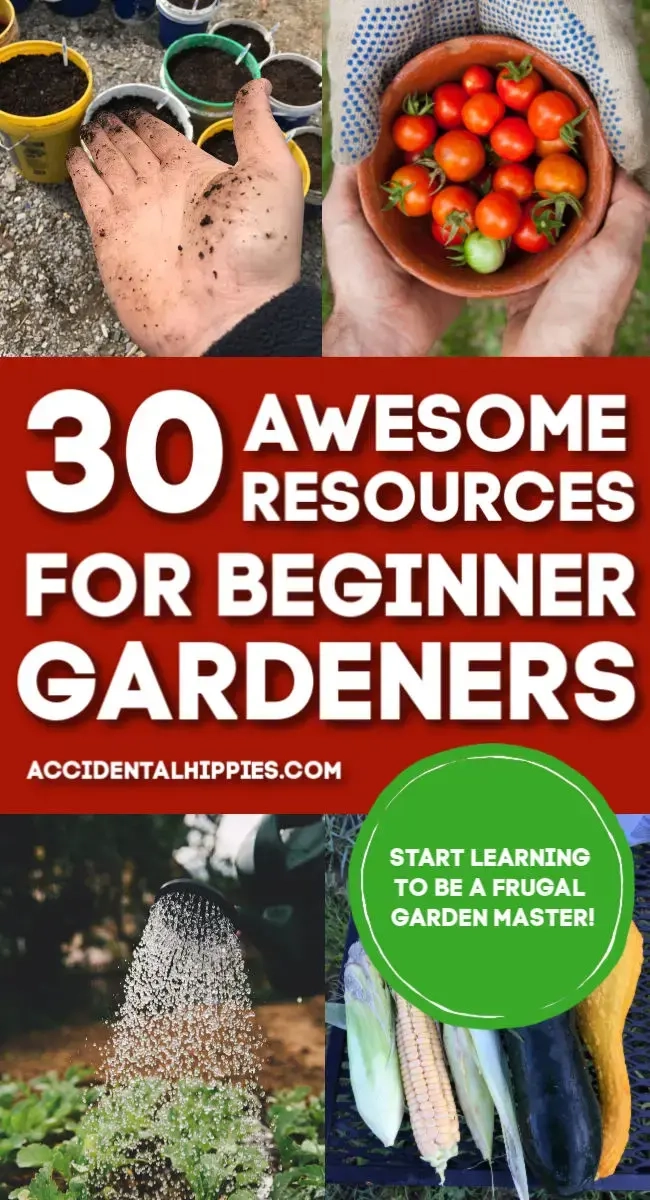
This resource page from Accidental Hippies focuses on homesteading, building with natural materials, and frugal living. It provides a range of resources, from online courses and beginner guides to specific gardening techniques and container gardening.
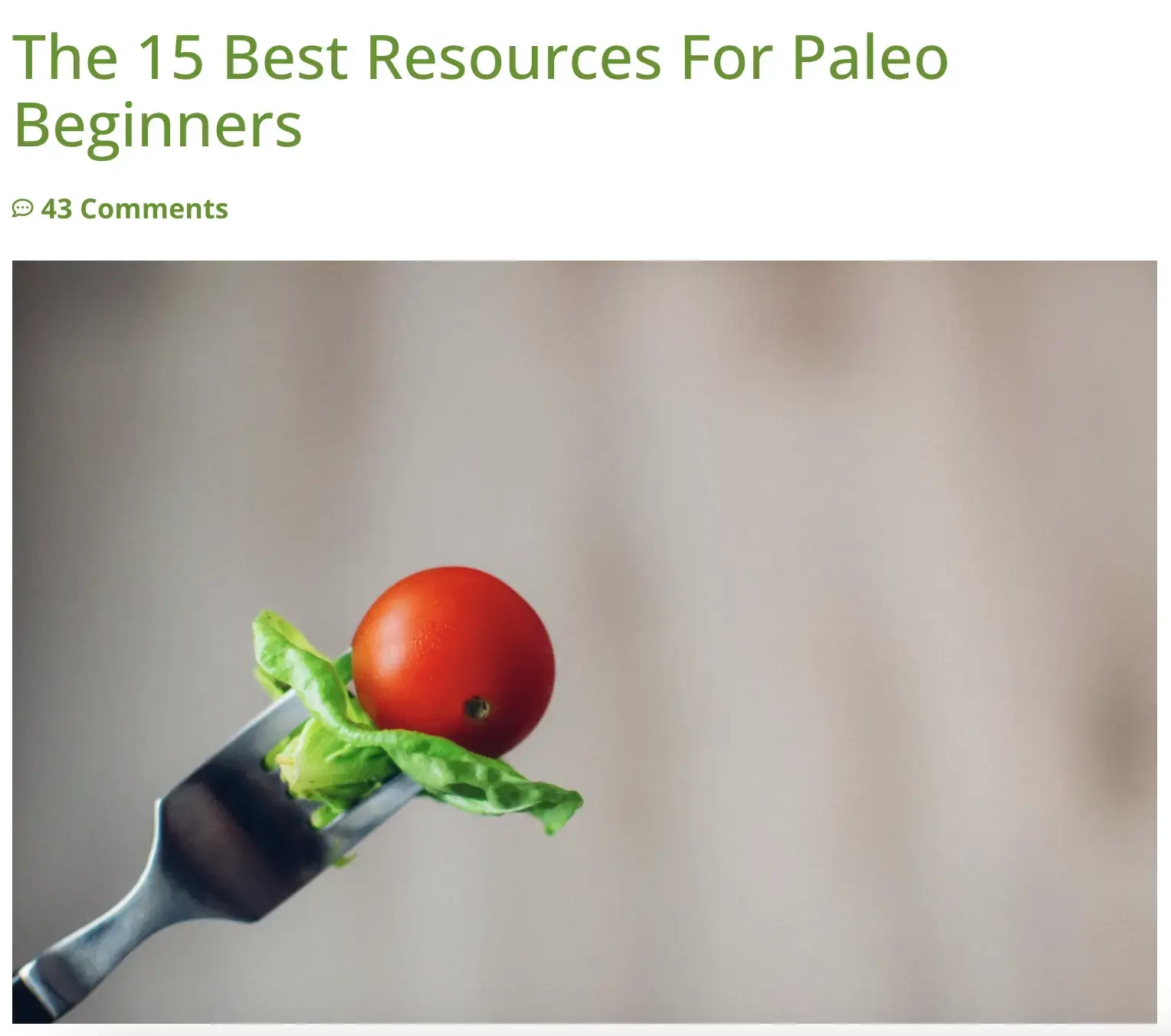
Well Fit and Fed’s resource page features websites, blogs, online courses, and product recommendations. It offers information that caters to various aspects of the Paleo lifestyle, from recipes to educational content.
A Step-By-Step Guide to Resource Page Link Building
Let's delve deeper into why resource page links are valuable.
Targeting resource pages is a powerful link-building strategy due to their niche relevance, which aligns closely with Google's ranking criteria.
💬 Google’s Ranking Criteria: Relevance
“Beyond looking at keywords, our systems analyze if content is relevant to a query in other ways.
We also use aggregated and anonymized interaction data to assess whether search results are relevant to queries. We transform that data into signals that help our machine-learned systems better estimate relevance.
Just think: when you search for “dogs,” you likely don’t want a page with the word “dogs” on it hundreds of times. With that in mind, algorithms assess if a page contains other relevant content beyond the keyword “dogs,”—such as pictures of dogs, videos, or even a list of breeds.”
Now you know what resource pages are and that they are sources of incredibly powerful link-building opportunities, this section explains how to build those links.
1) How to find resource pages in your niche
First, find relevant resource pages within your niche. This is typically the most time-consuming step in the resource page link-building process.
It's also the most important step. This is because it ensures that you target opportunities with the greatest potential to improve your SEO. It also helps you avoid wasting time pursuing irrelevant links.
Here are two methods you can use to find the best resource pages in your niche:
The Google method
Using Google is often the simplest and most effective way to find resource pages within your industry.
With Google's advanced search strings, you can refine your search results, making it easier to find resource pages:
Keyword “inurl:resources”: This search string tells Google to look for web pages where the URL contains the word "resources" along with your keyword.
Keyword “best resources”: By adding "best resources" in quotation marks after your keyword, you instruct Google to find pages where your keyword is mentioned with the phrase "best resources."
Keyword “useful resources”: Similar to the previous search string, this one looks for pages where your keyword is associated with the phrase "useful resources."
Keyword “intitle:links”: By adding "intitle:links" after your keyword, you're telling Google to search for web pages where your keyword appears in the title and is associated with the word "links." For example, the webpage title Free Fitness Workout Links includes the keywords “fitness” and “links”.
Keyword “helpful links”: This search string targets pages where your keyword is accompanied by the phrase "helpful links."
Start with broad terms to cast a wide net before honing in on more specific terms.
For example, begin with "nutrition" to find general resources, then narrow down to "paleo diet" for more targeted resource pages.
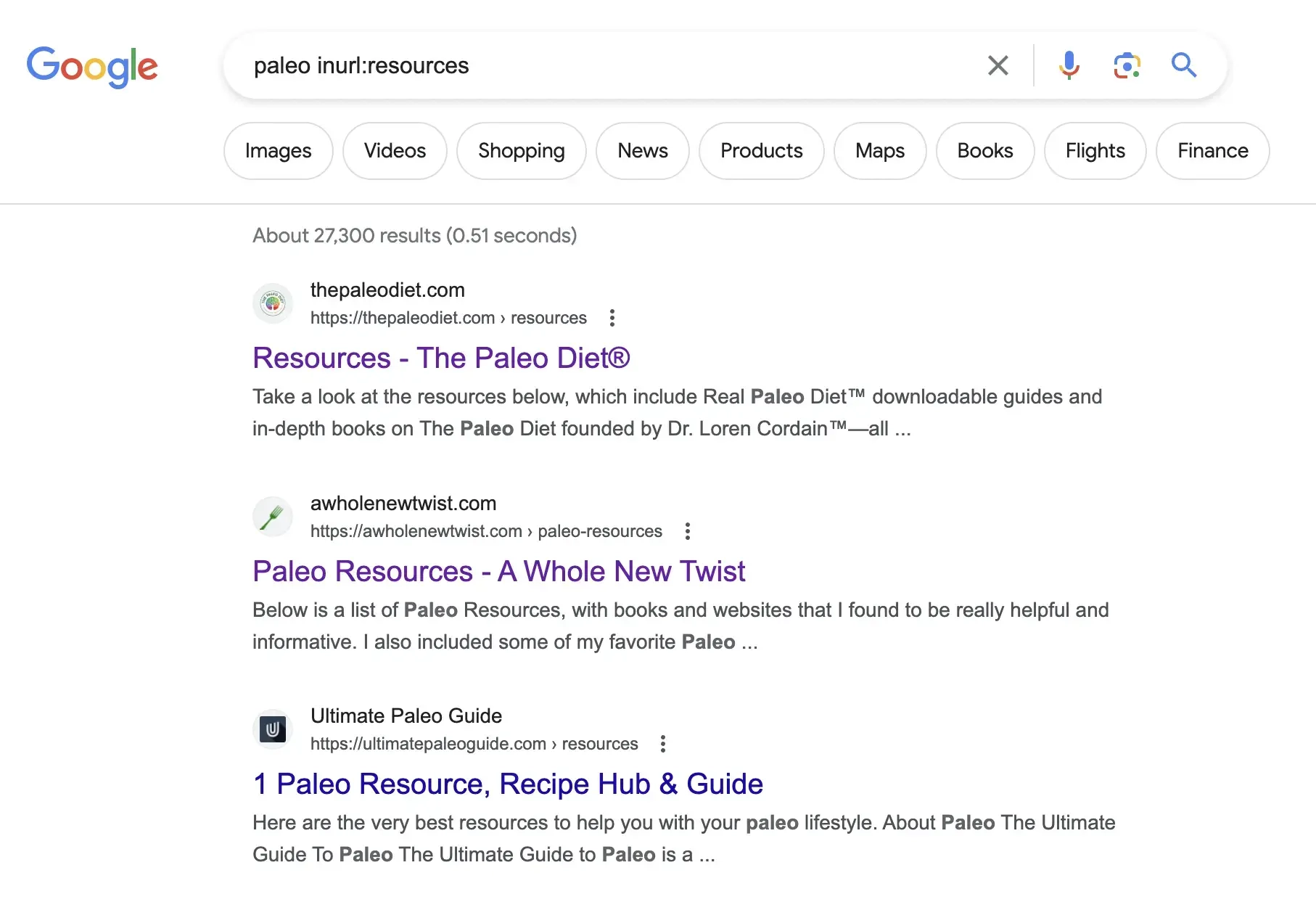
Reverse engineer competitors’ resource page links
Instead of starting your research from scratch, you can leverage the work your competitors have already done.
By checking the resource pages linking to your competitors, you can target sites in your niche that are willing to link out.
Here's how to find these resource pages with Semrush:
1. Add a competitor’s URL to Semrush
Let’s look at
how many resource pages The Paleo Diet blog mentioned earlier has been featured on:

2. Look at their backlinks
Click on the tab that shows their backlinks total:
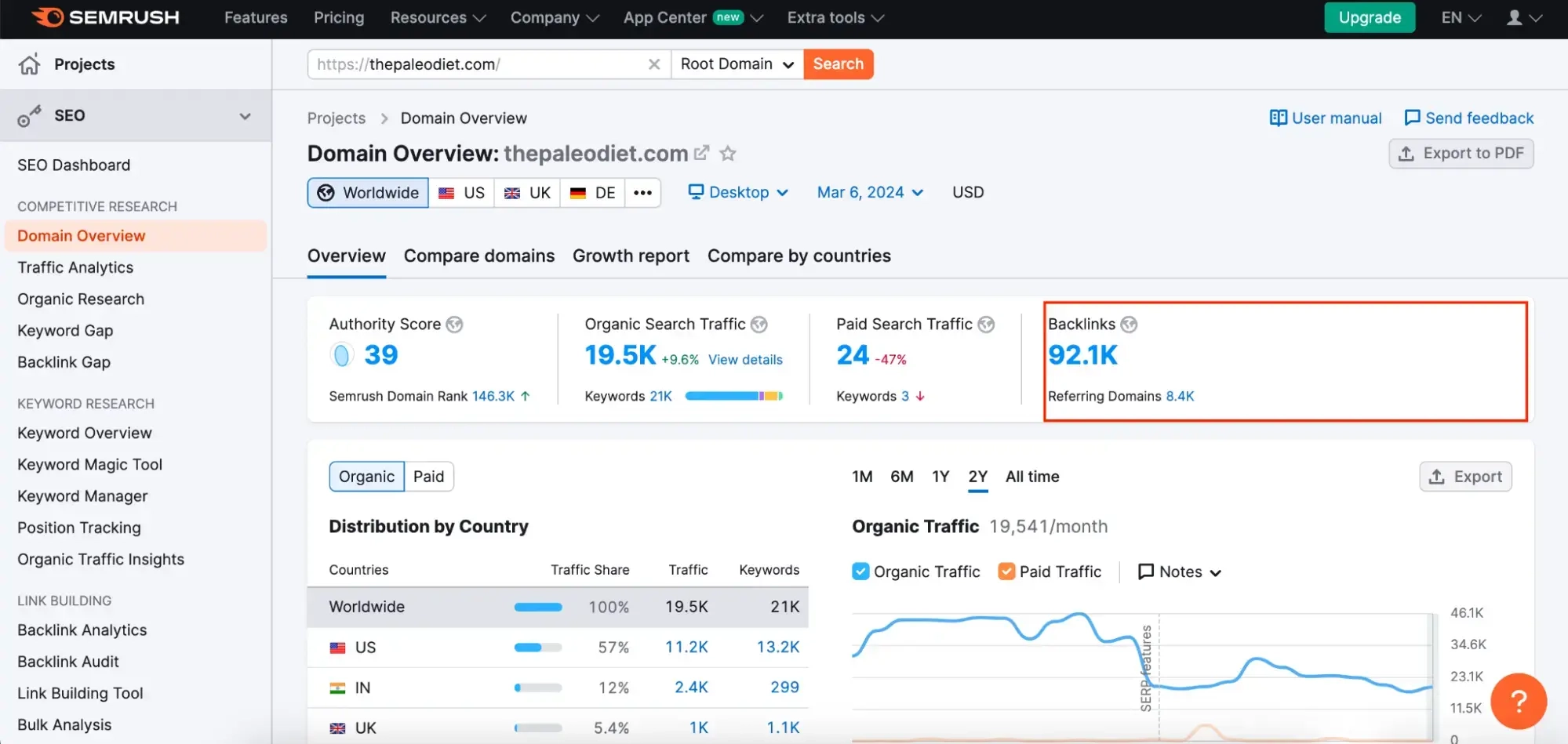
3. Search for terms that resource pages would use
Use search terms like “resource” or “guide” to narrow down your search to resource pages that your competitor has been featured on.
Once you have this list, check each resource page individually to see whether there are gaps in their content.

Look for broken links
Broken link building is not only a standalone link-building strategy, but also an effective technique for finding resource pages.
This method involves a two-step process:
Identify relevant resource pages within your niche.
Detect and report broken links on those pages.
By doing this, you show the site owner the problem they have and present them with a solution in one go. By making it easy for them to clean up their pages, you can increase the likelihood of your link being added as a replacement for their broken link.
Install the Check My Links extension on Google Chrome to simplify the process of checking web pages for broken links.
Once installed, navigate to a resource page and activate the extension:
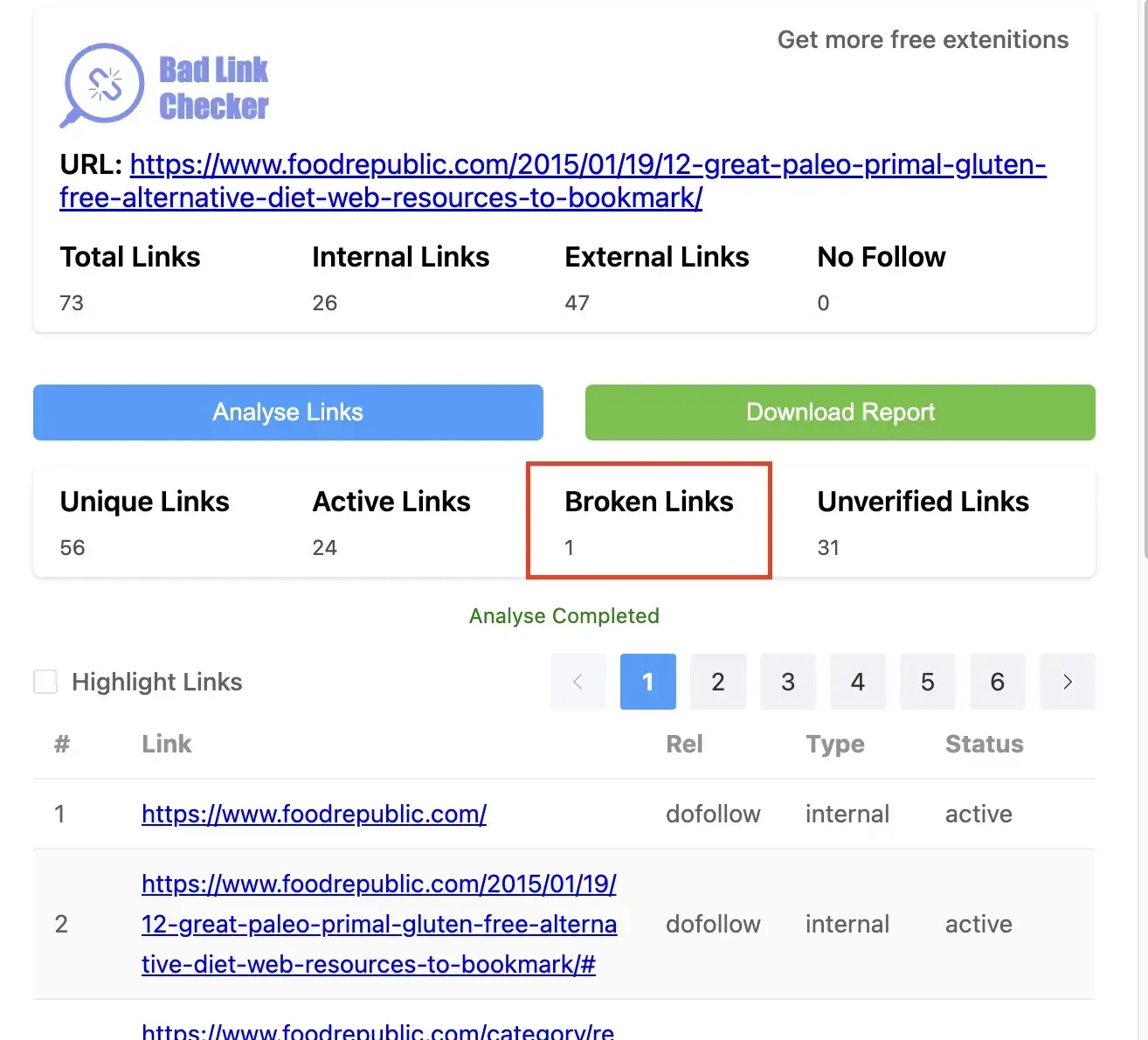
In the example above, there is one broken link on the page. You can click on “Download Report” to get a .csv file that will help you sift through the featured links.
💡Target Realistic Resource Pages
Not all resource pages are viable targets for your link-building efforts. Here's how to refine your list to avoid wasting time:
Exclude .gov or .edu pages: If a resource page only links to .edu or .gov websites, it's unlikely that they would add a link to your commercial or personal site.
Avoid neglected pages: Pages filled with outdated content and numerous broken links are probably not updated or visited regularly, reducing the benefits of having a link added.
Skip pages that only feature internal links: If a resource page only links to content within its own website, it probably won’t link to external sources.
2) Organize your findings
Organizing your research findings in a structured way is essential for a successful resource page link-building campaign. This is especially true when targeting numerous resource pages.
Creating a spreadsheet helps streamline the process, allowing you to track your progress and prioritize your efforts effectively.
Here’s a breakdown of essential headers to include:
Website URL
Page title
Niche
Domain authority (DA) or domain rating (DR)
Whether there are broken links on the page
Whether you have reached out to the webmaster
Work your way through the list of resource pages methodically; think how you’d want to prioritize the resource page owners you are going target with outreach:
By DA/DR: DA and DR measure of how authoritative a website is. Backlinks from high-authority sites are more effective at helping your website rank higher on search engines.
By broken links: As outlined earlier, offering to replace broken links with active links to your own content can give you a higher chance of success.
1. Find or create the best-fit content
Now that you’ve prepared a list of potential resource pages, the next step is to choose relevant content you’ve already created or create new content that aligns with their topic.
Here's how to ensure your content is the best fit:
✅ Skip service pages: Pages that openly promote your services or products usually don't offer value to the resource page's audience. In addition, these links appear self-serving and are less likely to be included.
✅ Identify relevant content: Scrutinize your content to find pieces that closely align with the themes covered by the resource pages you’re targeting. Blog posts, in-depth articles, guides, or studies are well-suited for resource pages because they provide informational value.
✅ Create new content: If your current content arsenal doesn't contain a match for the resource page, it's worth considering creating new content. Create content that complements the existing resources rather than duplicating them. For instance, if the resource page links to basic guides on a topic, you might create an advanced guide or explore a niche aspect of the subject.
✅ Analyze existing links: Study the outbound links already featured on the resource page. What topics do they cover? What formats are they in? This analysis can reveal gaps or opportunities where your content could add value.
✅ Ensure quality and relevance: Create high-quality content that’s directly relevant to the resource page's audience. It should offer clear, actionable, or insightful information that stands out as a valuable addition to the page.
💡Pro-tip: How to create best-fit content with ChatGPT
You can copy and paste a list of resources into ChatGPT, then ask it to give you some additional content suggestions that align with what’s already featured:
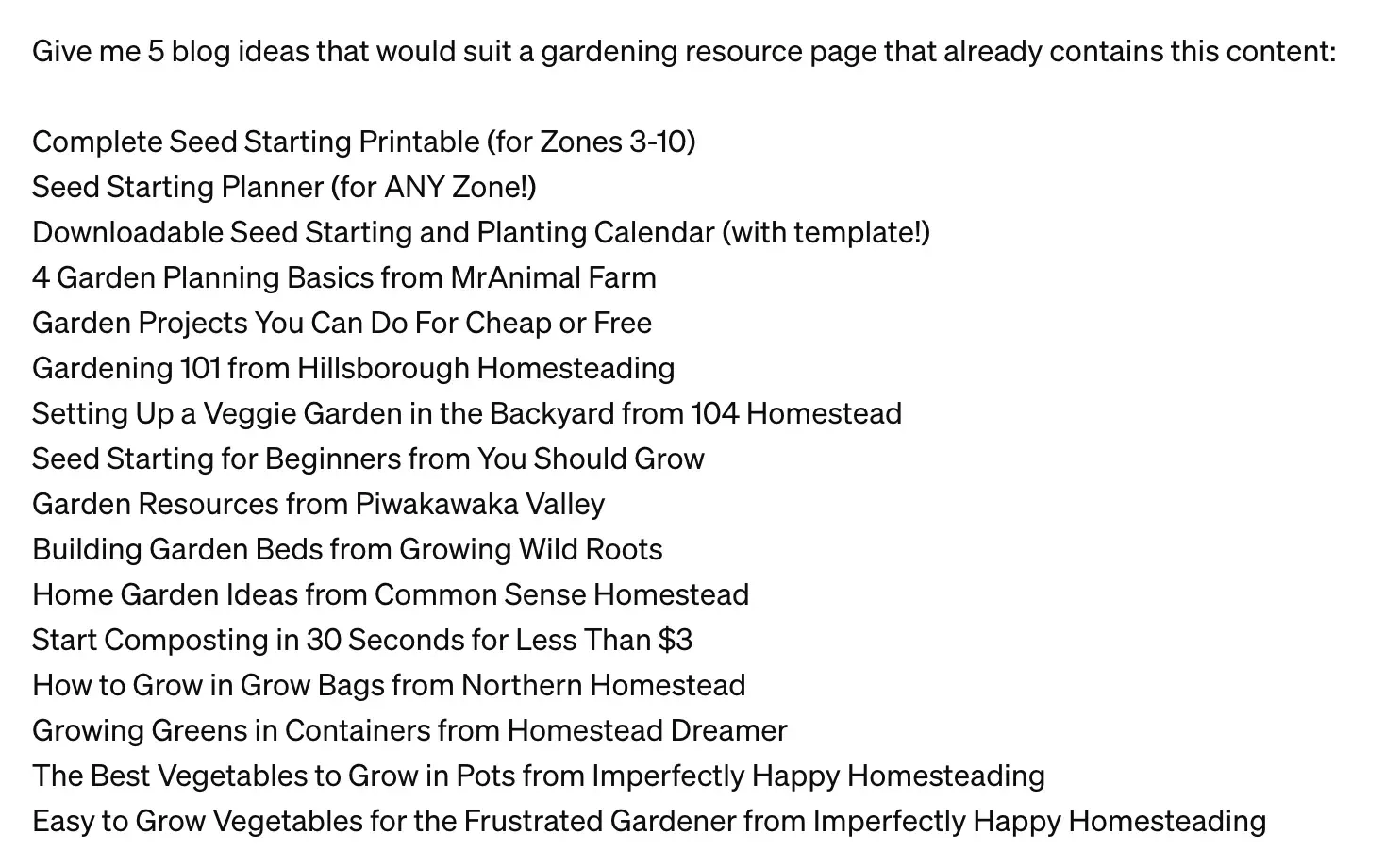
Based on the above prompt, ChatGPT provided five content suggestions that would probably appeal to the resource page owner and their audience:
⚡Companion Planting Guide: Boosting Your Garden's Productivity Naturally
⚡Water-Saving Tips for the Sustainable Garden
⚡The Beginner's Guide to Organic Pest Control
⚡Maximizing Small Spaces: Vertical Gardening 101
⚡Seasonal Garden Maintenance Checklist: What To Do Every Season
2. Reach out to the website owner
Instead of using a generic contact form, which might route your message into a general inbox, try contacting the relevant person directly. This might involve a bit of detective work on your part.
Start by checking the website's 'Contact Us' or 'About Us' sections, where direct contact details are often listed. If this doesn't work, looking at the website's LinkedIn profile might reveal the right person.
Once you've identified the right contact, it's time to craft your outreach message.
Rather than sending a generic request, explain where on their resource page your link could add value. For instance, highlight relevant sections or topics where your content complements existing information or fills a gap.
Your message should be friendly yet professional. Even if you start with an outreach template, adding personal touches—like commenting on a recent article they published or a specific aspect of their resource page you found useful—can go a long way in establishing a connection.
Using the example of a gardening website, here are two outreach template examples:
Template 1: Resource Page Link Building
Hi Emily,
I hope you’re doing well!
I'm impressed by the wealth of knowledge you share on Accidental Hippies. It's clear you've got a passion for empowering gardeners, and I think I've got something that could complement your resource page.
I've put together a Seasonal Garden Maintenance Checklist that breaks down garden tasks season by season: [LINK]
Since you already offer such a great mix of insights, I thought this checklist might be a perfect fit. I'd love for your readers to get a little extra value from the stellar advice you already offer.
Thanks for creating such an inspiring website for gardeners. I'm excited to contribute to it!
Template 2: Resource Page Link Building with a Broken Link
Hi Emily,
I've been exploring Accidental Hippies and it's amazing how much practical advice you've managed to pack into one place!
While browsing your resource page, I noticed the link to "Garden Projects You Can Do For Cheap or Free" isn't working anymore: [LINK]
I know how important it is to keep resources up-to-date, so I thought I'd give you a heads-up.
On that note, I have a resource that could be a great replacement.
It's called Budget-Friendly Garden Hacks for Every Home: [LINK].
I believe this guide could slot in seamlessly, providing your readers with fresh and practical tips. If you're open to it, I'd love for it to find a home on your resource page.
💡Pro-tip: Create outreach emails with ChatGPT
Writing personalized outreach emails is vital for establishing connections, but it can be time-consuming.
Instead of creating a generic outreach email template to save time, try using this ChatGPT prompt to create your outreach emails:
“Write an outreach email to [NAME] from [BLOG NAME] requesting the inclusion of one of my links to their resource page. Their blog typically outlines topics such as [LIST THE TOPICS]. My content is entitled [TITLE OF BLOG]. Note how my content fits into their resource page and adds value for their readership. Ensure the tone is friendly yet professional.”
5 Reasons Why Your Resource Page Link-Building Efforts Aren’t Working
If you haven’t been getting results from your resource page link building, it’s time to reassess your approach.
Here are a couple of key areas where you could be going wrong:
1. You’re not targeting the right resource pages
One common reason for ineffective link-building efforts is reaching out to unrealistic or outdated pages.
Ensure that the pages you target are relevant to your content and regularly updated. Website owners who have outdated or irrelevant pages are unlikely to link to your content or attract lots of traffic, no matter how valuable your link may be.
2. Your content doesn’t add value
Evaluate whether your content genuinely adds value to your target pages and their audiences. Here are some key questions to ask when evaluating your content:
Does the content address topics that are relevant to the audience?
Is the content too similar to the links it already contains?
Is the content well-written, visually appealing, and easy to read?
Does the content demonstrate expertise, authority, and trustworthiness?
Experiment with different content types—such as infographics, case studies, or videos—to see what resonates best.
3. Your website isn’t optimized
If your website is slow or poorly optimized, website owners may not want to link to it.
Here are some factors to evaluate:
Is your website easy to navigate?
Does your website load quickly?
Is your website optimized for mobile?
Is your content and design appealing and user-friendly?
4. Your outreach emails are missing the mark
Take a moment to review your outreach emails. Are they personalized and professional, or do they feel like generic spam? Avoid using cookie-cutter templates; instead, craft messages that speak directly to each recipient.
Show the recipient why your content would be valuable to them and their audience. Highlight the relevance and make it clear why they should take an interest in what you have to offer.
Don't be afraid to follow up politely with those who haven't responded. Sometimes, a gentle nudge can lead to a successful link placement.
5. You’re expecting results too soon
It's natural to want to see immediate results, but when it comes to resource link building, patience is key.
Remember, website owners may have tasks that are of higher priority than updating their resource pages.
With resource link building, it takes time to see results. On average, you might need to wait three to twelve months before you start noticing improvements in your search rankings and organic traffic.
Supercharge Your SEO Efforts with Linkbuilder
Are you struggling to get started or fail to see the results you’ve anticipated from your resource page link-building efforts?
You're not alone. From targeting the right resource pages to crafting personalized outreach emails and ensuring your content adds genuine value, there are many moving parts to consider. Building links can be a daunting task, especially when you're juggling other aspects of your business.
That’s where Linkbuilder comes in.
Our team specializes in navigating the complexities of link building to save you the effort. We take the time to understand your business, your goals, and your target audience. We then get to work identifying relevant resource pages, reaching out to website owners, and securing valuable backlinks for your site.
Get in touch and let’s start driving real results!
